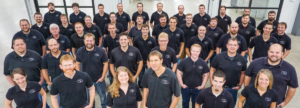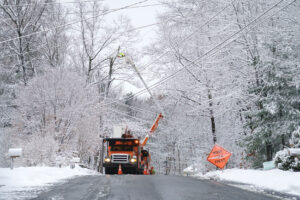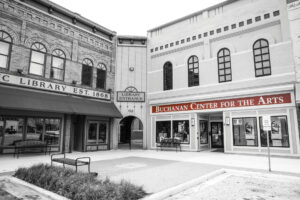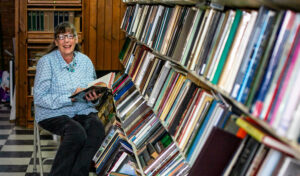In his youth, David Shaw had his head in the clouds, but instead of dreaming up a future in sports or traveling the world, David had his mind set on something much higher, literally. He dreamed of owning his own aerospace business right on his family’s farm. He told his friend, Adam Wesley, his plans and offered him a job on the spot.

Years later, David, along with his wife Penny, did just that. Flying S, Inc., an aerospace engineering company, opened for business in 2001, and once able, David stayed true to his word and Wesley became the first hire.
Tucked away in the countryside south of the small town of Palestine, Ill., Flying S sits on the same ground that has a long history in the Shaw family, dating back to the 1700s. For more than two centuries, the Shaw family has farmed these grounds.
Now, in the middle of pasture and herds of cattle, this land is home to an innovative, state of the art facility that designs and fabricates anything aerospace from conception to completion, from tip to tip. “We may be out here in rural Illinois, but we are part of this very cool industry,” says Penny.
Flying S builds unmanned airplanes and works on space programs, commercial aviation projects, and aircraft that have been used in the military. Notably, Flying S worked on NASA’s James Webb Space Telescope.
“I’ve always liked planes,” David says. “A lot of people in my family were pilots, but I didn’t just want to fly them, I wanted to build them.”
David’s family has a history in aviation. His great uncle was one of the first barnstorming pilots in the early 1900s. David’s grandfather and both of his parents also became pilots. Moreover, David’s father, John Shaw, attended the University of Illinois, became a mechanical engineer, and worked on space programs in the 1960s. “David was bound to catch that bug,” adds Penny.
David started flying at age 14, and at 16, he earned his private pilot license. A few years later, he followed in his father’s footsteps and went to the U of I and became an aeronautical engineer.

After earning his degree, David added several notable aeronautical items to his resume before opening Flying S. He worked for Cessna, an aircraft manufacturing company, and Burt Rutan, an aerospace engineer who designed the Voyager – the first plane to circle the globe nonstop.
During the time David worked for Rutan, he met Penny at a wedding, and the rest is history. In 2001, they decided to move back to the Shaw’s family farm.
“I was planning a house to build, and David said, ‘houses are cool and everything, but what we really need is a business if we want to stay here,’” Penny recalls. “So, we scrapped the house plans and we designed and built a barn that has an apartment in the top.”
The barn Penny referenced can be seen from the front door of the Flying S facility, across the road and partially hidden by a pasture. This unassuming burgundy building is where Flying S was born, and the Shaws live there to this day.
“That’s where it started,” Penny explains. “I think that it’s important to tell this story because it’s not like we went to the bank and got a whole bunch of money and made this. We started across the road working out of our home, very old school.”
Old school may be an understatement. The Shaws literally built their home from scratch, buying two semi loads of poplar logs and a small sawmill, and they made their own lumber. After the building was complete, they moved in, and after purchasing an old manual Bridgeport milling machine found in a shed and retrofitting it with a computer, Flying S was open for business.
“We just did a bunch of design consulting from home for several years,” Penny says. “We’d go out to Maine, do a project and come back. Then we’d go out to Washington, D.C., do a project and come back.”
Starting off as a consulting firm, Flying S had a slow and steady growth, and in 2007, hired its first employee, Wesley. The company then went from a design consulting firm to design building and testing. Since then, it continues to grow.
“We’ve worked on all kinds of different projects,” Penny explains. “We do a lot of prototyping, but occasionally some of that will become manufacturing projects. Some of these projects are for unmanned airplanes, some for space programs, and some of them are for commercial aviation.”
In 2012, the Shaws moved the business across the street into a new, much larger facility built to fit the needs of the growing company. Because of the rapid growth, the facility doubled in size a year later, and then it doubled again in 2016, making it a whopping 75,000 square feet.
Walking from room to room, the facility is like a maze. Each spacious room is different and serve separate purposes. One room is lined with aircraft wings at various stages of completion. This includes wings from aircraft returned to Flying S for repairs after being in service with the military.
Silence permeates another room as workers form carbon fiber into molds, which will later get baked to harden into aircraft parts. Other spaces include areas for inspections, 3-D printing, painting, metal working and laser etching.
The air is thick with moisture in another large room as huge machines drill into blocks of metal, shaping parts and pieces for aircraft. Jets of water spray the drills to keep them from overheating. Workers stand by programming the computers and keeping an eye on progress. Near each machine are large bins holding silver metal shavings, which will be recycled.
American flags hang from the ceiling in each room. This is not only fitting because Flying S is an American business, but also because every machine, tool and piece of material in the facility is made in America.
The cutting-edge facility is also equipped with solar power and geothermal technology. While it may have been costly up front, the Shaws look at it as a long-term investment.
“We believe in sustainable farming, so we also believe in energy independence,” David explains. “Energy costs will increase – which will increase costs in manufacturing. We have a well-insulated building, and geothermal helps keep heating and cooling costs down. We have sensitive, high-tech equipment that requires temperature control.”
Currently, there are approximately 60 full time employees mostly made up of engineers, machinists and composite technicians. Many of the employees are originally from the area. “We want our employees to want to be here,” David says.
Penny explains that turnover is costly, especially for them. Much of the training is done inhouse, so it takes a long time to build up a knowledge base. Located almost in the middle of nowhere, the Shaws want employees to want to live in the area, and they understand that’s not for everyone.
“We could have gone to Chicago to start this,” comments Penny. “But we don’t want to live in Chicago, we want to live here. There’s lots of talented people in this area, and we’re looking for craftsmen. What people do here is very hard, it takes a lot of patience and craftmanship.”
At the same time, employees don’t have to be from the area to work there. To prove this point, while David could always call Flying S home, Penny couldn’t be farther away from what she originally called home. She’s Australian, and never imagined her life would lead her to rural Illinois.
“I was eager to explore the world, but I had no idea I’d be married to an American,” Penny recalls. “I’ve lived (with David) from the Mojave Desert to Maine, so I’ve seen a lot of different states in America, but I really love it here in Illinois… There’s so much beauty in this country, but I love the Midwest.”
As important as it is to have employees who want to be there, the Shaws find that families play a vital and important role in the business. “The families are just as much a part of this as the employees,” Penny says.
The Shaws encourage spouses and children of employees to have lunch on the farm. There’s a playground and picnic area by the nearby pond, and there’s another playground underway. Families are also welcome to fish or walk on the trails on the farm and attend bowling or movie nights.
In 2014, Flying S launched the Flying S Cadets program that’s held every summer. Designed for area children, this program gives kids the opportunity to learn about science in a fun, engaging way. Workshops include rocket building and launching, a paper plane tournament and obstacle course, and CO2 pine derby car building and racing.
The idea is to provide a spark of interest within these youths for engineering and aerospace. “We want children to see that there’s a reason you have to do well in science and math,” Penny says. “You can’t contemplate a career in a business that you’ve never been exposed to.”
While the Flying S Cadets program isn’t a recruiting tool, the Shaws want to introduce kids to the industry that they are passionate about. “By interacting with our engineers, technicians and machinists, it makes it more real for them,” Penny says. “That’s really what this is about, trying to encourage them to think about what they might want to do, and this is a completely legitimate industry to think about.”
For Penny, one of the most exciting parts of Flying S Cadets is to witness the aha moments with these youngsters. “I just think it’s really neat. You can just see the light bulb moments when things start to make sense for them,” Penny says with a smile. “They really are learning. They’re not just sitting there not paying attention. They’re getting this, and I think that’s really exciting to see.”
In addition, Flying S has hosted a countless number of tours for schools and colleges. “I’ve lost count of how many tours I’ve done,” Penny explains. “I just had 30 children in here this morning for a tour. I sometimes do several a week.” Penny says that student tour groups travel from all over Illinois and Indiana. They do private tours, too, with visitors from across the country.
Depending on the day, a tour group may see a herd of cattle near the Flying S headquarters. Although Flying S is an aerospace manufacturing company, these cattle play an important, yet separate role for the company. Flying S also sells beef that are raised on the family’s farm. David’s father, John, takes care of the cattle, and Penny sells the beef.
On the farm, there are no crops at all. There are only pasture and a herd of grass-fed cattle. As members of the American Grassfed Association, all cattle owned by Flying S, and other members of the Shaw family, have a strict diet of clover and grass. There’s a big reason for that.
John Shaw had heart surgery in 1999, and he nearly died. The doctors told him he needed to cut beef from his diet. After completing his own research, John concluded that it wasn’t about beef, but the type of beef. His research found that grass-fed beef was healthier than grain-fed.
Almost 20 years later, John keeps busy on the farm, caring for the cattle. He lives just two miles down the road in the family’s farmhouse built in the 1800s. Commenting on his son’s business venture, John says with a laugh, “I’m not surprised by anything David and Penny do anymore.”
David and Penny find it rewarding to have created a business with humble beginnings to where it is now. Not only have they created jobs in the area, but they are also producing aircraft that are saving troops’ lives and going to space.
“I always wanted to come home and start a business, and it’s always good to be diverse on a farm,” David says. Penny adds, “It’s amazing what you can find in the middle of a cow pasture.”








